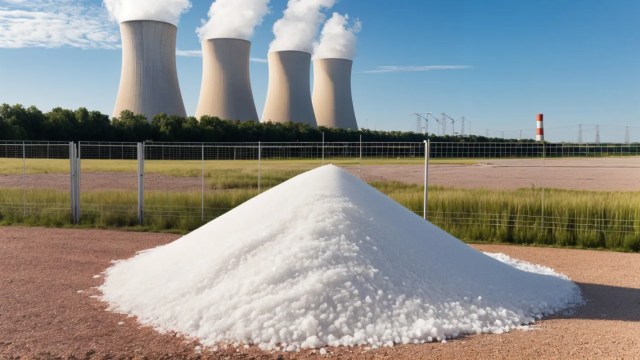You don't have to be J. Robert Oppenheimer to know that nuclear energy is a powerful energy source.
These innovations have great potential to add to the 10% of global electricity generation that the International Energy Agency reported already comes from reactors.
1. A nuclear solution for water woes

Texas' Abilene Christian University and nearby Natura Resources are working on a small, modular molten salt reactor that operates at 1,112 degrees Fahrenheit.
The molten salt acts as the fuel and coolant. Waste heat will be used in a desalination operation, also purifying wastewater from oil fields, according to Interesting Engineering. While the tech is promising, the Union of Concerned Scientists raised safety concerns. Officials in Abilene plan for the reactor to go online by 2027. Desalination will be added soon afterward.
Read more →
2. An Italian nuclear energy boom?

Atomic energy is poised to provide air pollution-free power to Europe's boot by the end of 2027 after a four-decade ban that followed the deadly 1986 Chernobyl disaster in what was then the Soviet Union. The onus behind the reversal is clear. If even 11% of the country's electricity is produced by reactors, it would shave $17.7 billion off the cost of decarbonizing its economy by 2050, per Reuters.
The European Nuclear Society reported that atomic material contains up to 3 million times the energy, per 2.2-pound equivalent, of oil or coal. However, Colorado-based RMI physicist Amory Lovins told The Cool Down that nuclear power is costly and that renewable energy from the sun and wind are better choices for grid-level projects. RMI is an energy think tank.
Read more →
Watch now: Giant snails invading New York City?
3. Artificial intelligence could unlock molten salts

Russian nuclear energy scientists are utilizing artificial intelligence to understand how the substances react at various high temperatures on the atomic scale. The goal is to produce next-generation reactors that create more energy with less radioactive waste.
AI can speed up the data processing at a reduced cost. The experts are from Skoltech and the Institute of High Temperature Electrochemistry of UB RAS, according to findings published in the Journal of Molecular Liquids.
Read more →
4. Turning nuclear waste into harmless glass

Washington State University researchers are working to improve a nuclear waste storage process that turns it into harmless glass through vitrification. The scientists can detect salt in the waste using millimeter wave technology with terahertz radiometry.
Chloride and fluoride salts that form during vitrification can disrupt the process, causing leaks, according to the study. By finding the formations early, the experts are hopeful they can better manage high-level nuclear waste, alleviating one of the main concerns for the power source.
Read more →
TCD Picks » Quince Spotlight

|
Which of these factors would most effectively convince you to support nuclear energy projects in your area? Click your choice to see results and speak your mind. |
5. Nuclear-powered ships

Reactor-powered cargo haulers could help nix air pollution from a sector that is widely reported to generate around 3% of our planet-warming carbon dioxide emissions. In answer, Norwegian shipbuilder Vard is teaming up with the Norwegian University of Science and Technology to convert fossil-burning ships into nuclear ones, according to Interesting Engineering.
The team is analyzing fourth-generation nuclear reactors to determine the safest option. While nuclear meltdown on the high seas is a terrifying prospect, Geopolitical Intelligence Services reported that the latest tech has made atomic energy "safer than ever" — safer than heat-trapping fossil fuels in regard to deaths from its use to make electricity.
Read more →
Join our free newsletter for weekly updates on the latest innovations improving our lives and shaping our future, and don't miss this cool list of easy ways to help yourself while helping the planet.

















